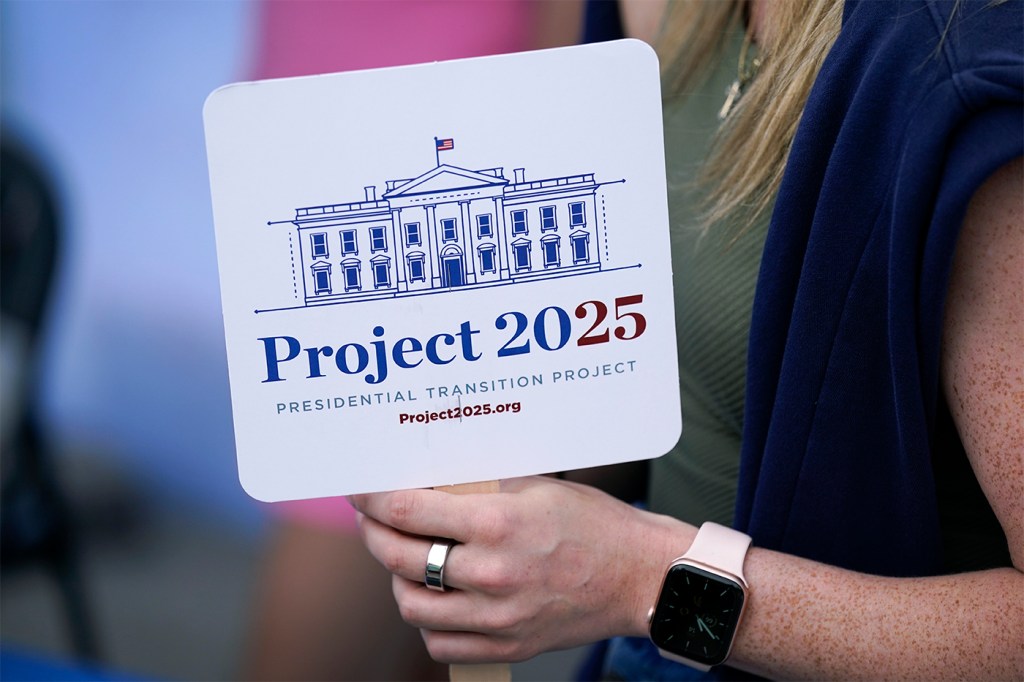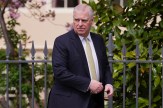Expert says ‘big chunk’ of Project 2025 could become policy during second Trump presidency
The 922-page document outlines a series of policy proposals that would fundamentally transform the nature of the federal government, experts say. Is the blueprint really a “government-in-waiting?”

Project 2025, the Heritage Foundation’s latest vision for a potential second Donald Trump presidency, has been under the microscope since the Republican National Convention commenced this week in Milwaukee.
The 922-page policy document outlines a series of policy proposals that would fundamentally transform the nature of the federal government, Northeastern experts say. Such objectives call for dismantling the “administrative state” through, among other things, the elimination of whole departments; the reclassification of civil servants into political appointees (known as the Schedule F plan), thus stripping them of protections; and a “mass deportation” plan that the Heritage Foundation proposes as the largest in the nation’s history, the document reads.
Is Project 2025 really a “government in waiting”? Many of the ideas contained in the blueprint reflect the Republican Party platform as it stands, from immigration to government and regulatory overhaul and education reform.
But the sprawling ideological document could contain the means with which to execute on many of those party objectives, testing the viability of a whole host of radical policies at a moment when Republicans control the judiciary, experts say.
“I think there’s a high probability that a big chunk of it gets promulgated, especially if the Republicans control both chambers of Congress,” says Christopher Bosso, professor of public policy and political science at Northeastern University.
The role of think tanks, and a brief history
Nick Beauchamp, associate professor of political science at Northeastern, says think tanks, as organs of political, economic and policy expertise, influence the political process in several ways. They shape “people and personnel” when it comes to presidential administrations; and, secondly, they facilitate funding for both causes and candidates.
“The money that comes in is spent in two ways: on bringing people under their umbrella to write these documents, who then become schooled in the organization’s viewpoints and eventually go out into administrations” to directly influence policy, Beauchamp says.
“The other way the money works is that it’s coming into the think tank operating through the same class of donors who are donating both to these think tanks and the candidates themselves,” he says.
It’s been shown that the agendas think tanks take up often reflect the interests of their donors. But think tanks can shape who the donors give to during elections. That, in turn, “causes people to pay a lot more attention to them,” Beauchamp says.
While U.S. think tanks play a considerable role in politics and public policy, Bosso says there’s an asymmetry in how they’re organized around the two major political parties and the ideas they champion. As an instrument for churning out ideas, the Heritage Foundation is one of several policy institutes expressly devoted to promoting a conservative vision of American society. There “really isn’t a parallel” on the Democratic side because, Bosso says, “the left is never as organized” as the right.
“The Heritage Foundation is part of a larger tradition on the right, going back to at least the 1950s, of conservatives being funded by very wealthy people,” Bosso says. “And that’s been the story, which is that the right has always been much more well-funded in terms of the willingness to fund think tanks like Heritage, like the Manhattan Institute, and others at the state level.”
Founded in 1973, Heritage Foundation came into existence as something of a counterpoint to the free-market oriented American Enterprise Institute, with a greater emphasis on cultural issues, Beauchamp says. Those “who founded it thought that the American Enterprise Institute was too academic, in a sense. They thought it was too nonpartisan; it was too small-c conservative,” he says.
Heritage Foundation out front in 2024
Think tanks largely conduct their work in the background, often to little fanfare — although their experts frequently make the rounds on cable news, Beauchamp says.
That hasn’t been the case this election cycle. This month, the president of Heritage Foundation, Kevin D. Roberts, said the nation was in the midst of a “second American Revolution, which will remain bloodless if the left allows it to be.”
Those comments generated a flurry of publicity around Project 2025 — so much so that Trump himself seemed to have distanced himself from it. This is despite the fact that a great many (at least 140) former Trump administration officials were involved in the project, according to CNN. Roberts’ comments also came on the heels of a Supreme Court decision that states that former and future presidents are entitled to some immunity from prosecution for actions taken while in office.
“His comments, combined with the recent Supreme Court decision, I think, caused a lot of people to sit up a lot more and pay attention” to the latest of Heritage’s “mandate for leadership,” Beauchamp says.
Concerns about Project 2025 center around its apparent endorsement of a controversial — and untested — theory: the so-called “unitary executive theory,” a Reagen-era view of executive power that looks to give the president greater control over the federal bureaucracy. The implications of putting such a theory in practice would be “contrary to what the framers of the Constitution had in mind,” Bosso says — that is, a limited government, with checks on executive power.
Editor’s Picks
“This an old, old notion, mostly found in conservative Catholic thought, but even in some conservative views about the unitary state: that the government is essentially the arm of something like a king, and that the president is almost like the divine right monarchy,” Bosso says.
“If they implement this Schedule F plan and essentially remove civil service protection from thousands and thousands of workers, and they’re able to put their loyalists in place — that right there is a game-changer,” he says. “Because now you have the people and the mechanics to carry out these agendas, even if Trump himself is not focused on them.”
“If [Trump] also happens to carry Congress, then there are fewer brakes on him than there were before,” Bosso continues. “The first time around, he was inexperienced, and he had a lot of inexperienced people around him. This time around, there’s going to be a lot of experienced people, and they’re going to be much more organized.”
Among other measures included in Project 2025 is a call to withdraw mifepristone, a pill widely used in abortions, from the market; a proposal to ban pornography, with consequences for tech companies that permit it; and a plan to beef up border policing by dismantling the Department of Homeland Security and combining its immigration enforcement power with other agencies.
Of all the proposed policies, Beauchamp says the Schedule F plan is among those “most likely to be implemented.”
“I don’t know how strong the legal grounds are for doing this, because these things are written in part by Congress,” he says. “Of course, with the Supreme Court on their side, it doesn’t really matter. They can interpret these things as they want.”










